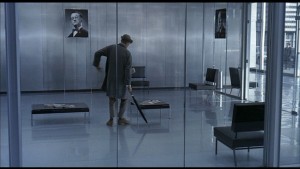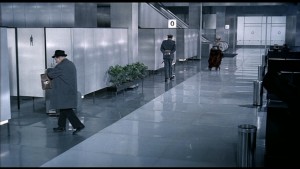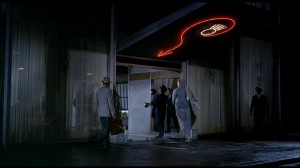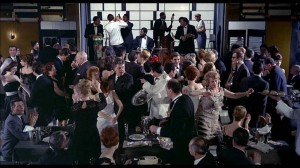From Film Comment, Winter 1971-72. This was my second Paris Journal for that magazine, and my first extended effort to write about Playtime. -– J.R.
All five of Jacques Tati’s films have musical backgrounds of such surpassing unsubtlety that they are insipid even by Muzak standards; processions of cute kids, dogs, and middle-class nonentities that are not so much mildly parodied (on the surface) as embraced and advertised; the kind of comic ambiance that usually attracts either a Saturday afternoon family crowd or no one at all. Of the four that I have seen, two (MON ONCLE and TRAFIC) repeatedly grate on my nerves, and one (LES VACANCES DE MONSIEUR HULOT), after several viewings, has come to seem like an enduring classic. For the other, PLAYTIME, I would gladly trade the collective works of Fellini, Bergman, and all but the best of Godard.
Four years after its opening in Paris, PLAYTIME remains, at this writing, unseen and virtually unknown in the states. The European reception has generally been so cold that distributors are probably afraid to go near it. To speak even of its existence here is to conjure up a ghost: unquestionably Tati’s most expensive and ambitious film — requiring, according to Télé-Ciné, “ten years of reflection, three years of preparation and shooting,” and filmed in 70 mm and stereophonic sound — it already seems destined to share the fate of extravagant commercial failures of the silent era like INTOLERANCE, GREED, and SUNRISE. Certainly it is no less audacious than any of these in what it sets out to do, or in what it requires from an audience.
Perhaps the true anomaly of Tati’s career is not so much the commercial failure of PLAYTIME as the relative success enjoyed by the others, particularly LES VACANCES. Eschewing the speed, momentum, and athletic virtuosity of the Sennett-Keaton-Chaplin school, and most of the Pavlovian audience-conditioning that this school excels in to elicit laughs, Tati usually requires something of the contemplative awareness that we bring to a film by Bresson or Ozu.
A simple indication of Tati’s difference can be observed in a typically bizarre shot from LES VACANCES: in the left foreground, a waiter slices meat, while in the right background, a series of vacationing guests enter the dining room at regularly spaced intervals, through a squeaking door. Compositionally, this shot — like so many others in the film — is a kind of audiovisual juggling act, with each slice of the knife echoed by the sound of the door opening and closing, and each slice of meat “rhymed” with another entering guest. But rather than attempt a symmetrical balance between these elements, Tati times and spaces the entrances and slices with the playful rhythmic displacements of a piano solo by Thelonius Monk. Just as Monk will run a short melodic phrase through a long series of minor variations, often changing its plastic shape by the delay of a single beat, the addition of a note, or a slight reshuffling of the melodic sequence, Tati likes to create similarly suspenseful guessing-games with his own audience. Thus the gag equation of guests with slices of meat, which for any conventional comic director would be the content of the scene, becomes for Tati an occasion for playful formal variations. Keaton, one suspects, would have made the point once and moved on to something else, but Tati is so interested in the ways this game can be played that, for some spectators, the equation is never precisely stated at all.
In PLAYTIME, the resources of wide screen and stereophonic sound permit Tati to extend this preoccupation to the point where it becomes not merely a means for articulating gags, but a complex vision of the world.
***
A group of female American tourists arrive at Orly airport, take a bus into Paris, and spend the day there. “Paris” is a complex of glass-and-steel skyscrapers, all virtually interchangeable with Orly, each other, and– judging from the evidence of several travel posters — with foreign capitals throughout the world. The nostalgic sights of Paris (Eiffel Tower, Concorde, Sacre-Coeur) are glimpsed only as fleeting reflections on the glass surfaces. As the Americans and other tourists roam the streets, and ramble through an international exhibition of commercial gadgets, their path is occasionally crossed by M. Hulot, who is wandering through several buildings in search of a M. Giffard (we never learn precisely why). Occasionally we see Giffard searching for Hulot, confused by several “false” Hulots (people resembling Hulot at a distance) or by reflections of Hulot on the panes; at one point, running toward a “false” Hulot, he runs smack into a glass door, injuring his nose… As dusk falls, business executives get into their cars, buses leave, and the lights of the city turn on. We see Giffard, his nose bandaged, out on a walk with his dog. Purely by chance, he runs into Hulot in front of the Royal Garden, an expensive restaurant that is preparing to open.
The next hour of the film chronicles the opening night of the restaurant, from the arrival of the first customers until dawn. The opening is a bit premature, and as the night wears on we witness a growing deterioration of the Royal Garden: the glass door at the entrance is shattered, the heating system runs haywire, some of the decor comes loose, the electricity shorts. Parallel with this coming apart of the establishment is the coming together of nearly every character in the film, as a roomful of strangers slowly turns into a community of acquaintances. Hulot is brought to the restaurant by an old army pal he runs into, who works there as a doorman; he dances with a girl in the tourist group, and later re-encounters a German salesman from the gadget exhibition. Gradually, the scene turns into a boisterous party, presided over by a loud, free-spending American; when the electricity shorts and the dance band leaves, the girl is enlisted to play the piano . . . In the morning, most of the people leave the restaurant to have breakfast at Le Drugstore a block away. Afterwards, Hulot hurriedly buys a going-away present for the girl; unable to deliver it himself, he asks a younger man — a “false” Hulot — to give it to her before she boards the bus. As the bus leaves, the girl opens her package and finds a bouquet of plastic flowers. Outside, we see the flowers visually echoed by the streetlamps on the highway leading to Orly. The scene abruptly changes to the same setting at dusk, then at night. The final shot of the film, accompanied by triumphant music, is of Orly seen from a distance, surrounded by a myriad of glittering lights.
Scarcely discernible in the above summary is the multitude of events and the relationships between them that animate PLAYTIME, especially in its second half -– a richness of detail and design that over a dozen viewings have failed to exhaust. Cahiers du Cinéma reports that the elaborately detailed script runs to 500 pages, and the remarkable thing about that figure is how short it is, considering the amount that happens over 137 minutes. (1)
Ten years before the release of PLAYIME, Godard had the wit to call Tati the father of French neo-realism, and however odd this formulation may seem at first, it is easy enough to see what he meant: like Rossellini, Fellini and De Sica in their early films, Tati’s focus is trained on the epiphanies of everyday life. As he has himself pointed out in several interviews, the basic principle behind his humor is observation. But a fundamental aspect of his observed epiphanies is that they usually occur in a virtual vacuum of normality, a universe where generally “nothing” happens. It is even possible to regard his gags as punctuation for a ”text” composed of empty space and uneventful moments –- a peculiarly Zen-like attitude, reflected in the shot from LES VACANCES described above, where comedy equals not so much the gags themselves as the mere possibility that they might occur. (2) “The 70 mm format,” Tati has said, “corresponds to the dimensions of the contemporary world,” and a statement of his in 1958 is particularly revealing about his didactic aims: “I’d eventually like to make a film without a central character, with nothing but the people I observe and pass on the street, and prove to them . . . that the comic effect belongs to everyone.”
To “prove” this, Tati has to teach us a new way of looking, and like any true education, this must begin with a dismantling of what we think we already know. During the first hour of PLAYTIME, when all of the characters are wandering about helplessly, the spectator’s eyes are forced to share some of this condition — a sense of dislocation in which one has only the vaguest notion of where one is, and even less of an idea where one is going: the archetypal situation of the tourist. Looking around restlessly is nearly all that one can do, and one looks around in the hope of being led –- into a story, a character, a setting, an idea, into anything that will hold the attention and assume some sort of continuity. Ordinarily, one would expect to be led by Hulot, but this is precisely where Tati has betrayed his Saturday afternoon audience. Hardly more than an extra himself in a film of extras, Hulot can lead us nowhere because he is lost himself. Lost to us a great deal of the time, when he is missing from the screen – a fact underscored by all the “false” Hulots, who keep confusing us — and the least helpful of all possible guides whenever he is on.
The sheer logistics of this alienation are effected by a combination of strategies: all of the action is filmed in long shot, much of it is densely populated, and a great deal of it is simultaneous. But where Tati departs most radically from the conventions of classic cinema is in his multiplication of focal points. Refusing, throughout much of the film, to specify what we are to look at and listen to, he forces us to choose.
***
The first shot of PLAYTIME, like the last, confronts us with a faceless building; Tati cuts to an interior, and several minutes pass before we realize that we’re in an airport. The inhabitants of an endless stretch of waiting room are as plainly dumbfounded by their surroundings as we are: a passing nurse suggests a hospital, a strutting military man makes us think of a government center.
When we arrive at the Royal Garden, however, we know exactly where we are. Significantly, Tati’s reconstruction of our sense of place begins to occur at the construction site of a restaurant that is hastily preparing to open while it is still being built By sharing the spectacle of the restaurant’s frantic preparations, Hulot and Giffard finally succeed in finding one another, which they have been trying to do for most of the film’s running time. As a plot development, this meeting is trivial andanticlimactic, since we never learn why they wanted to find each other in the first place. But structurally it is crucial, for it signals the dozens of meetings that are about to take place in and around the Royal Garden, the gradual assembly of all the characters into an integral community — a process that is accompanied and even encouraged by the restaurant’s disintegration Thus it announces a total inversion of the film’s first half. Halfway through the film, the buildings have triumphed over all of the characters, defeating every visible desire The remaining hour shows the people taking over again, reclaiming, instinctively, what is rightfully theirs.
Viewed purely as a virtuoso piece of mise en scène, this hour is one of the most staggering accomplishments on film. Without resorting to a single ellipsis, Tati persuasively delineates an evening in its entirety, and makes its development a continual movement towards celebration. The social cohesion that forms before our eyes is brought about so gradually, through a wealth of so many individual details, that our experience of it is both logical and sublime; all the wandering strands of the film are brought together and weaved into a rich tapestry of possibilities Unlike our freedom of choice in the film’s first half, when our gazes are circumscribed by the mazes the architecture leads us through and the ambiguities their glass reflects, our vision encompasses a Breughel-like universe of jostling humanity, and our uncertainties about where to look for future gags (which are proliferating everywhere) become occasions for surprised delight. Suddenly, we find ourselves players rather than victims of the director’s master game, and our eyes roam the room like excited partygoers. By focusing on so many different people at once, Tati eventually persuades us to join them.
Perhaps this is why, when the tourists depart on their bus, he can succeed gloriously with a poetic conceit that darker times would have deemed unthinkable: turning early morning Paris traffic into a circus of carouseling cars and festive flags. “Paris nous appartient,” one is tempted to say, robbing Jacques Rivette’s title of its essential irony. The plastic flowers that echo the streetlamps epitomize the reconciliation of people and places; they are Tati’s parting gift to his audience. And to my way of thinking, anyone who can convince me that plastic flowers are beautiful must be a magician.
End Notes
1. When PLAYTIME opened in Paris, its running time was 15 minutes longer; in mid-February, 1968, Tati cut the film himself down to its present length, a move regretted by many who saw the longer version. Cf. Cahiers du Cinéma #199, which contains a 25-page tribute to the film, including an extensive interview with Tati.
2. In the same issue of Cahiers just cited, Noël Burch has several useful things to say about Tati’s “refused” gags.








